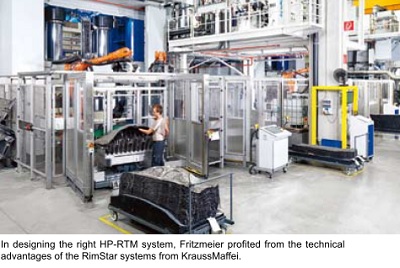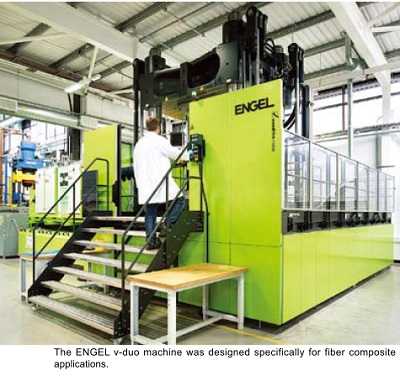Cost-effectiveness, process reliability and reproducibility are the requirements when it comes to producing components made of carbon-fibre-reinforced plastics. In this area, the use of high-pressure resin transfer moulding (HP-RTM) has gained acceptance.
Producing CFRP components in large-scale series is a standard made possible, thanks to the market launch of electric cars such as the BMW i3 as well as many other factors. The HP-RTM from KraussMaffei supports processors on their path towards increased automation and short cycle times.
At its Bruckmühl location in Bavaria, the Fritzmeier Composite GmbH & Co. KG, develops and produces a wide variety of top-class components for the automotive industry based on fibre-reinforced composites. The list of well-known references includes large automakers such as BMW (particularly the BMW i3 as well as Mini), Mercedes Benz and Rolls Royce. In 2014, the company invested in another HP-RTM machine from KraussMaffei and produced, among other creations, carbon-fibre-reinforced components for the bodywork of the BMW i3. "Very short cycle times were a requirement for the design of the HP-RTM machine. KraussMaffei produced a system solution perfectly designed for our requirements," explains Stephan Fraunhofer, Head of Development at Fritzmeier.
The result is a customized HP RimStar Compact in the design of a 4-strand machine with four mixing heads. Two presses can be operated at a time using this machine. By using switchover units, two presses with dual cavities can be operated using a single 4-component machine. This avoids the need to invest in an additional metering system.
An additional challenge was the matrix material in use, which is a highly reactive and particularly corrosive epoxy system. The special distinguishing characteristics start at the selection of the axial piston pumps, which move the material to the mixing and metering systems. Fritzmeier benefited from the in-house pump manufacturing of KraussMaffei in this area.
The RimStar series mixing and metering systems from KraussMaffei are also optimally designed for processing of fast-reacting epoxy systems. The specific defining features are the flexibility and high product quality with low scrap rates. "High-pressure injection using the RimStar series enables the processing of fast-reacting resin systems. This makes it possible to quickly fill the mold for fibre-reinforced components to the benefit of shorter cycle times," explains Fries.
The RimStar Compact 8/4-8/4 HP-RTM at Fritzmeier is equipped with four MK 10 2C RTM mixing heads. This allows for perfect premixing of resin and hardener and works according to the self-cleaning principle. Release-agent metering at the mixing head, including the corresponding release agent station, complete the efficient mixing head system. Systems with demanding processing temperature requirements can be metered to perfection with RimStar high pressure RTM metering machines. High-pressure engineering ensures that the components are thoroughly mixed in the mixing head.

Precise control assurance
ENGEL supplied the 1,700-ton press with a mold and integrated HP-RTM equipment, ENGEL v-duo, at WMG’s Automotive Composite Research Centre at the University of Warwick. With a mold mounting surface of 2.2 by 1.8 meters the machine offers WMG the opportunity to produce a multitude of components and use different materials and manufacturing processes. WMG is a research and education group based at the University of Warwick and works collaboratively with global companies to develop innovative products, services and processes. Prof. Ken Kendall, Professorial Fellow at WMG's Automotive Composite Research Centre commented: "As a development partner with the automotive industry, flexibility is very important to us. The ENGEL v-duo enables us to research thermoset composites prepreg compression moulding (PCM), sheet moulding compound (SMC) compression moulding, HP
RTM and stamp forming of thermoplastic composites. The precise control provided by this equipment is an essential feature for us when researching these processes.” With the machine, the Centre hopes to help the automotive sector tap into innovative technologies, using the industrial-scale machine to develop mass-production processes for the manufacture of fibre reinforced composite components.
A further advantage is that the HP-RTM unit, which ENGEL implemented in cooperation with its system partner Hennecke (in St. Augustin, Germany), has been integrated into the machine's control unit, meaning the entire manufacturing process can be managed via the machine's display. The ENGEL v-duo machine was designed specifically for fibre composite applications. Compared to conventional presses, the ENGEL v-duo is 50% shorter in terms of height and about 60 per cent lighter. The large vertical machine, which is available with clamping forces from 4,000 to 36,000 kN, therefore makes it possible to create compact production cells at low investment costs.
The ENGEL v-duo is characterized by a very high degree of rigidity and excellent platen parallelism. Platen-parallelism control for injection compression moulding is included in the standard version of the machine. In addition, handling devices that move straight into the mold area can be integrated to save space. Using the sliding tables, insertion tasks and set-ups can be carried out flexibly and easily. The hydraulic accumulator has been done away with completely, and with the ecodrive servo-hydraulic system fitted on the standard version of the machine, the ENGEL v-duo is setting new standards in energy efficiency too.

Fibre-to-composite direct moulding process
ADEKA Corporation and GH Craft Ltd., the Teijin Group’s composite structure design, development and evaluation unit, have jointly developed the world’s first fibre-to-composite (FtoC) Moulding Process to laminate fiber-reinforced plastics (FRP) in open molds.
The FtoC Moulding Process automates resin impregnating, curing and laminating processes while aligning highly oriented fibers. A special new rapid-curing epoxy resin developed by ADEKA enables FRP to be cured in just tens of seconds with GH Craft’s new moulding process using infrared radiation. Large-scale equipment such as curing ovens and press molds are not needed because the FRP can be laminated in an open mold. Also, compared to conventional composite production, the FtoC Moulding Process considerably reduces fiber waste by directly moulding fibers to the composite without requiring intermediate steps. Moreover, by extending and highly orienting fibers, the process produces glass-fiber-reinforced plastics (GFRP) that offers significantly improved performance, including 100% more bending strength, 40% more tensile strength and 75% percent more interlayer shear strength compared to conventional GRFP made with conventional RTM.
Going forward, ADEKA will develop lineups of specialized resins for the FtoC Moulding Process and GH Craft will develop practical applications. ADEKA and GH Craft will jointly verify the effectiveness of the FtoC Moulding Process through the manufacture of practical products. Furthermore, the companies aim to jointly create a new composite market sector by working to establish the FtoC Moulding Process as a de facto standard for FRP production.
FRP is made of aligned unidirectional fiber that is impregnated with matrix thermoset resin and then molded by heat. Conventional thermoset moulding processes, such as autoclave and RTM, have drawbacks including long manufacturing cycles, high production costs, including for large equipment such as curing ovens and press molds needed for large-scale composites, and the need for intermediate trimming steps that produce large amounts of fibre waste.














